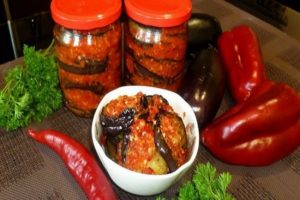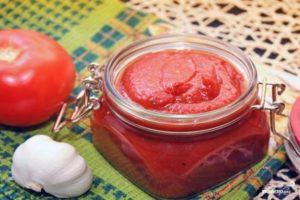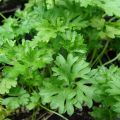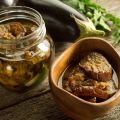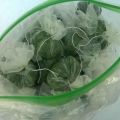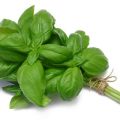TOP 10 delicious recipes for preparing celery for the winter at home
A culture from the umbrella family has been known for a very long time. According to Greek myths, Aphrodite used celery, striking in its beauty. The plant gave strength to the courageous Hippocrates, Cleopatra knew about the amazing properties of leaves and roots. Now the vegetable is a part of cosmetics, it is used for the prevention of diseases. Housewives are looking for different ways to preserve celery for the winter, without which the soup will not be fragrant, and the salad will lose its piquancy. There are about 20 varieties of this culture, and it is found everywhere.
The benefits of celery
Until the 17th century, the plant, whose relatives are carrots, coriander, parsley, was used as a medicine, and only centuries later began to use it as a food product.
The roots and ground part of celery contain:
- amino acids;
- essential oils;
- various vitamins.
Trace elements are represented by phosphorus, magnesium, calcium, sodium, iron. In 100 grams of greens there are only 13 calories, in the rhizome - 42. The culture is rich in purines, acids - nicotinic, folic, ascorbic, chlorogenic. It contains dietary fiber, proteins, lutein.
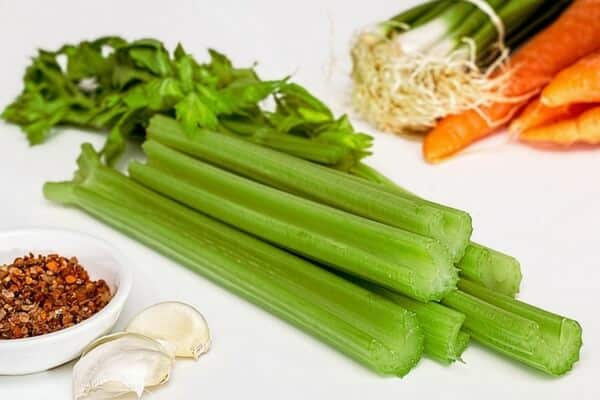
When eating celery:
- The pressure decreases.
- Immunity is strengthened.
- Wastes and toxins are removed.
- The nerves calm down.
- The metabolism is accelerated.
The plant prevents the formation of gases in the intestines, improves the production of gastric juice, and normalizes the water-salt balance. In men, when eating a vegetable, potency increases. Celery acts as an antioxidant, slows down the aging of cells in the elderly.
Due to the presence of essential oils, the plant:
- It has a positive effect on the skin.
- Returns appetite.
- Promotes the restoration of vision.
Medicines produced using culture relieve pain, heal wounds, treat urticaria, and improve sleep. A spicy vegetable helps to remove extra pounds, enhances sexual desire in women.

Petiolate and leaf celery, differences
The umbrella plant, which has an unusual taste and specific smell, is eaten raw, added to salads and dishes. In culinary recipes, all parts of celery are used, which is divided into 3 types, the petiole vegetable grows for 2 years. First, the greens are harvested, the next season the seeds ripen.
On a thick stem, leaves of a light green color are formed, which have a special aroma. Petioles grow from a powerful root, similar to a rod.So that they do not taste bitter, you have to huddle the bushes. Small white flowers that appear by the end of summer are collected in umbrellas. When they ripen, capsules form where the seeds are located.
There are many vitamins and essential oils in the stems of this type of celery. The plant is used for conservation, removes excess fluid from the body. Lotions from the leaves heal wounds. In salads, stalk celery is combined with carrots and dill. Its aroma enhances the taste of soups and main courses. The disadvantage of this umbrella culture is that it does not tolerate frost, has a short growing season, and suffers from powdery mildew.
Leaf celery is planted in dachas and vegetable gardens for the sake of greenery, which is cut all summer. There are no root crops, no petioles, but the culture takes root in the harsh conditions of Siberia, is not afraid of frost. The leaves are much more useful components than other types of celery. They are used as a condiment, in salads and baked goods.
The root type of the umbrella culture has a long growing season, this celery is grown not by seeds, but through seedlings, the leaves are not cut off.
Root crops weighing more than 600 grams are of particular value.
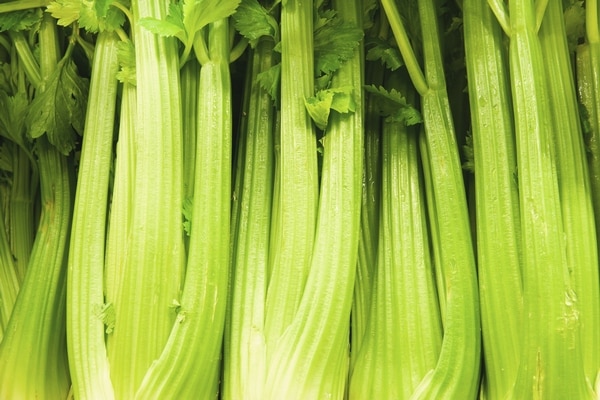
We prepare the main ingredients
Petiole celery is harvested in October. At this time, there is a lot of juice in the stems, useful substances accumulate in it. The root species is not afraid of frost, they undermine it with a pitchfork so as not to damage the fruit, which is well stored in the cellar, if left in peat or in wet sand.
The petioles are washed, damaged and dried. They hibernate normally if the stems are folded in a bag and found in the refrigerator. This part of the plant is suitable for preparing various dishes.
A leafy type of celery is laid in bunches on a surface where the sun does not fall. It dries under parchment for 30 days, after which it is crushed, poured into a glass container and used as a seasoning.
Celery recipes at home
In the winter months, the umbrella culture, which has a unique composition, is not always sold in stores. Many housewives have learned how to harvest leaves, petioles, and root crops on their own, which allows them to preserve essential oils, amino acids, vitamins and other components until the beginning of summer.
Using a simple recipe that works at home, it's easy to make a seasoning. To do this, you need to take a bundle:
- dill;
- celery;
- parsley.
The greens are chopped with a knife, rubbed with a glass of salt and laid out in glass jars.

Some gardeners have been harvesting different vegetables in the fall to put them in borscht in winter and eat them fresh. Following the recipe, use:
- carrots, tomatoes and onions - 1 kilogram each;
- dill, parsley celery - on a bunch;
- pepper - 300 grams.
Chop greens and tomatoes, chop the rest of the vegetables. The workpiece is mixed with a spoonful of salt and placed in jars in the refrigerator.
How to keep celery fresh
The fruits of the umbrella culture do not lose the main components within 7 days if placed in a plastic wrap in the refrigerator. For long-term fresh storage, the vegetable is placed in the sand and taken to a cellar or placed in cellophane bags and sent to the basement, where the humidity is high and the air temperature is within one degree.
Root crops will not rot until spring if they are laid out in rows in the cellar.
For stalked and leaf celery, storage options are also selected:
- The greens are salted, let it brew for a couple of days and rolled into jars.
- A fresh herb is frozen in molds with ice. It does not lose its aroma, vitamins or amino acids.
- Leaves that are placed in dishes are left in the freezer, packed in a plastic container that does not allow air to pass through.
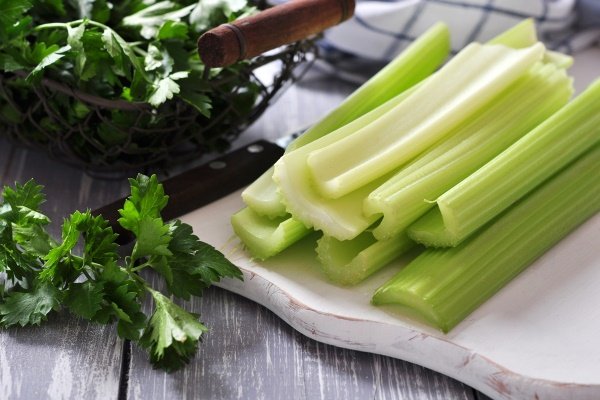
Celery wrapped in foil keeps its appearance and freshness in the refrigerator for over a week. In plastic wrap, it will fade in 3 days.
A plant dug out from the root, together with a lump of earth, is placed in the basement in the sand. It will stand until spring.
Drying
The leaves of the umbrella culture do not lose most of the essential oils, acids and trace elements if you use one of the simple and affordable harvesting methods.
Celery leaves are separated from the stalks, knitted into bunches and dried, hanging to the wall or ceiling in the kitchen or veranda, which is well ventilated, but the scorching rays of the sun do not reach there.
The leaves can be laid out on the surface and covered with paper, they will dry longer, but will not lose their useful properties. Dried greens are crushed and placed in a container.
Freezing
Due to the fact that celery contains a large number of unique components, one cannot do without it even in winter. For this, they resort to various storage methods. The leaves are placed in ice molds, where water is poured. You can also freeze stalks of stalked celery, which are put in a plastic container, and, like greens, are sent to the freezer.
Those who prefer this method of long-term storage of the plant should know that with this option it loses many useful components. However, many gardeners like to freeze greens.
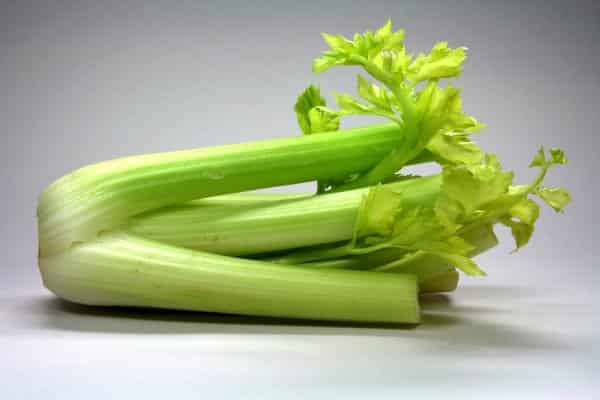
Dry salting method
To keep the vegetable fresh, making it convenient to add it to various dishes, you can use a simple recipe. A kilogram of clean and dried leaves is mixed with a glass of table salt and placed tightly in a glass dish. When a liquid forms in the jar, it is rolled up and taken to the basement or cellar.
The billet obtained by the dry salting method has a very salty taste and is used as a seasoning for salads, main courses and soups.
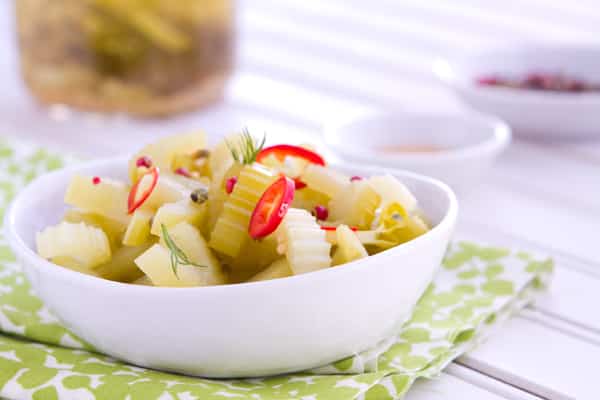
Pickled root and petioles
The leaves and stems of the umbrella plant are not only dried and frozen. A savory snack for meat, fish dishes and potatoes, where all the useful properties of the vegetable are preserved, is obtained by pickling the root. For cooking, you need the following ingredients:
- celery - 1 kilogram;
- coriander and salt - 2 teaspoons;
- sugar - 20 grams;
- oil - half a glass;
- vinegar and soy sauce - 4 tablespoons.
- red pepper - a whisper.
The root crop must be peeled and cut into pieces or chopped on a grater, pressed with your hands so that it starts up the juice.
In hot sunflower oil, you must first add salt, sugar, and then put coriander and pepper. When bubbles appear and the mixture becomes homogeneous, pour the vinegar and sauce. Warm marinade is gradually added to chopped celery, the mass is left overnight so that it is saturated with spices, and rolled into storage containers.
A flavored snack is obtained from the leafy umbrella crop. Cloves of garlic, a couple of bay leaves and celery are placed at the bottom of sterilized liter jars.
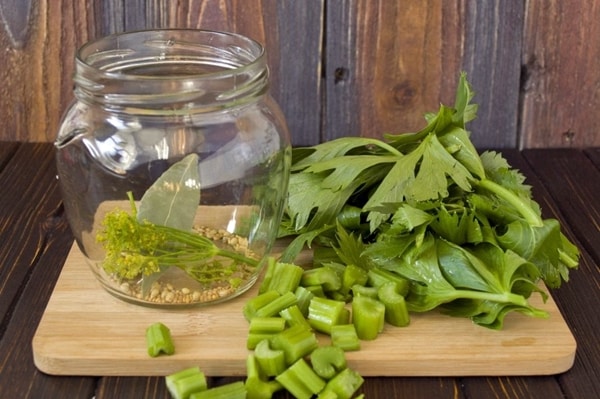
Marinade is made from the following ingredients:
- 0.1 kilograms of sugar;
- 70 grams of salt;
- liters of water;
- glasses of vinegar.
Jars are poured with a boiled solution, after which they are sterilized for 20 minutes and rolled up with lids.
Pickled petioles have an original taste and are served with meat, side dishes, salads. To prepare for the winter:
- The celery stalks without leaves are cut into small pieces.
- The garlic is peeled and divided into teeth.
- Seeds are removed from hot pepper, the fruit is crushed into plates.
- The onion is cut so that large rings are obtained.
- Plant leaves, spices, garlic are placed at the bottom of the jar.
- The second layer consists of onion and pepper stalks.
- The contents of the dishes are filled with boiling water and left for half an hour.
- The resulting infusion is poured into a saucepan, where 2 tablespoons of sugar and one salt are poured, boiling for 2 minutes, add vinegar.
- Vegetables in jars are seasoned with marinade, after cooling, they are rolled up with lids.
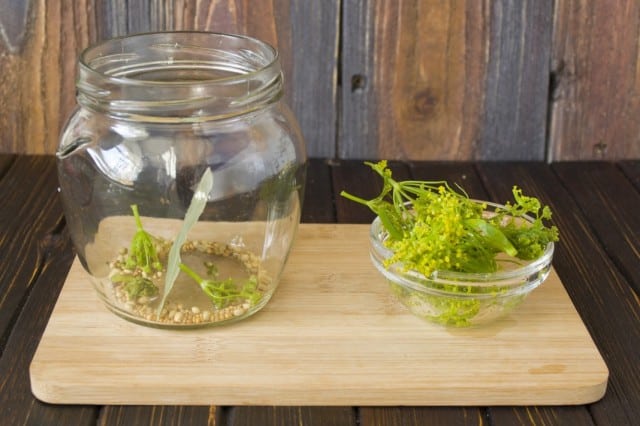
To prepare such a snack you need:
- onion –2 heads;
- garlic - 3 teeth;
- pepper - a pod;
- petioles and leaves - 400 grams;
- vinegar - half a glass;
- water - 400 milliliters;
- spice.
Celery marinated according to this recipe can be consumed after 2 weeks. In a cold place, the appetizer does not spoil for a long time, has a spicy aroma, surprises with its original taste.
Marinated with cucumbers and carrots
Celery goes well with vegetables and berries. The resulting blanks saturate the body with a mass of vitamins and microelements. Most cooking recipes can be mastered by any housewife. To prepare a crispy appetizer that resembles an oriental salad, you will need:
- petioles - 1 kilogram;
- carrots - 700 grams;
- cucumbers - 500 grams;
- dill - a twig;
- water - 300 milliliters;
- vinegar - 3 tablespoons;
- parsley, cloves;
- salt - spoon;
- sugar - 15 grams.
The celery stalks are washed, peeled, cut into pieces 3-4 centimeters long, and the cucumbers - into thin slices. Carrots are chopped. Everything is put in a glass jar. Salt and sugar are poured into a container with water, vinegar is added and put on fire. After 15 minutes, vegetables are poured with boiling marinade. The sterilized snack is covered with a cloth for a day, after which it is taken to a cool place.

Canned celery in tomato sauce
The petiolate species of an umbrella plant is harvested for the winter in tomato juice. Fresh red fruits must be minced. Mashed tomatoes must be cooked for an hour. Oil is poured into the resulting sauce, chili pepper, cut into pieces, sugar and salt are placed. After 20 minutes, put the crushed petioles into the mixture and boil it for another half hour, then fill with vinegar.
Mix a bunch of dill, celery leaves and parsley with salt and put in jars. For the recipe are selected:
- tomatoes - 2 kilograms;
- plant stems - 1000 grams;
- pepper - 1 piece;
- vinegar - spoon;
- sugar and salt to taste.
Preservation is rolled up in sterile jars. Leaf celery, carrots, onions, tomatoes and bell peppers are used to make a soup mixture for the winter.
How and where to store it correctly
The roots and stems of the plant are rich in substances that are necessary for the body, and in winter they are not enough. Leaf and petiole celery do not lose useful components if stored:
- in a refrigerator;
- in the freezer;
- in dried form.
In greens rolled with salt, vitamins and amino acids, essential oils are present until spring. At room temperature, fresh leaves should be used or eaten within 4 days.
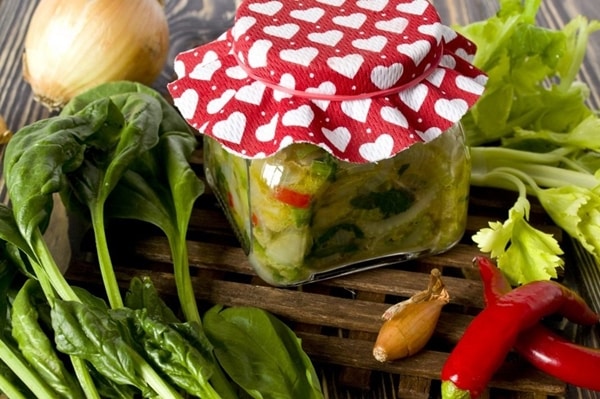
Root vegetables wrapped in plastic wrap will not deteriorate within a month at 3 ° C. They will lie in the cellar for up to six months if they are packaged in plastic bags or placed in wooden boxes, sprinkled with sand. But the temperature there should not exceed 2 degrees.
For long-term storage, choose smooth roots with an even peel without dents, cracks, knots. The presence of voids is evidenced by a dull sound that can be heard by tapping on the vegetable. Such celery has poor keeping quality.
Bright greens are suitable for storage. Wilted stems speak of a stale plant. The varieties of leaf and petiole types of culture, after washing and drying, are wrapped in foil and placed in the refrigerator, finding a place on the upper shelf.
Celery root vegetables can be grated, folded into bags and sent to the freezer. They do not rot, do not dry out in wooden boxes with sand, located on a glazed balcony or loggia, but in severe frost, the vegetable will have to be removed to the apartment.
Salted, pickled, canned products, rolled up in sterile jars, lie perfectly in a cellar, basement or refrigerator.
Properly dried celery leaves and stalks retain beneficial components throughout the year. Frozen greens do not lose their taste, aroma and vitamins. It is cut into pieces, put in molds with ice.
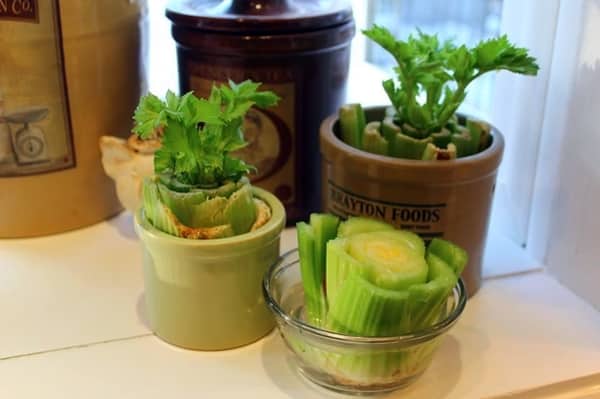
Despite the huge benefits of celery, the vegetable is not recommended for everyone. It is necessary to give it up for people suffering from nephrolithiasis, since kidney stones can begin to move. You should not eat root vegetables, pickles and pickles from greens for patients with thrombophlebitis, epilepsy, pregnant women, lactating mothers.
All other people need to include in the diet both greens and celery roots. They will help you lose weight, calm your nerves, and improve your appetite.
